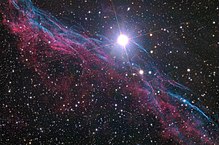astro.wikisort.org - Star
52 Cygni is a giant star in the northern constellation of Cygnus with an apparent magnitude of 4.22. Based on its Hipparcos parallax, it is about 291 light-years (89 pc) away.
| Observation data Epoch J2000 Equinox J2000 | |
|---|---|
| Constellation | Cygnus |
| A | |
| Right ascension | 20h 45m 39.75304s[1] |
| Declination | +30° 43′ 10.9756″[1] |
| Apparent magnitude (V) | 4.22[2] |
| B | |
| Right ascension | 20h 45m 40.206s[3] |
| Declination | +30° 43′ 12.96″[3] |
| Apparent magnitude (V) | 11.06[3] |
| Characteristics | |
| Spectral type | G9.5III[4] |
| U−B color index | +0.88[2] |
| B−V color index | +1.05[2] |
| Astrometry | |
| Radial velocity (Rv) | –0.72[5] km/s |
| Proper motion (μ) | RA: –8.98[1] mas/yr Dec.: +24.11[1] mas/yr |
| Parallax (π) | 16.22 ± 0.19 mas[1] |
| Distance | 201 ± 2 ly (61.7 ± 0.7 pc) |
| Details | |
| Mass | 2.07[6] M☉ |
| Radius | 13.81[6] R☉ |
| Luminosity | 89[7] L☉ |
| Surface gravity (log g) | 2.5[7] cgs |
| Temperature | 4,677[7] K |
| Metallicity [Fe/H] | −0.24[7] dex |
| Rotational velocity (v sin i) | 3.7[7] km/s |
| Age | 2.27[6] Gyr |
| Other designations | |
| A: HR 7942, HD 197912, HIP 102453, SAO 70467 | |
| B: TYC 2687-2652-1 | |
| Database references | |
| SIMBAD | A |
| B | |

52 Cygni is a probable horizontal branch (red clump) star, fusing helium in its core, although there is a 25% chance that it is still on the red giant branch (RGB) and fusing hydrogen in a shell around an insert core. As a clump giant it would be 2.27 billion years old, but only 910 million years if 52 Cygni is an RGB star.[6] It shines with a bolometric luminosity of about 90 L☉ at an effective temperature of 4,677 K.[7] It has a radius of about 14 R☉.[6]
At an angular separation of 6.0″ from 52 Cygni is a faint magnitude 9.5 companion.[4]
References
- van Leeuwen, F. (2007), "Validation of the new Hipparcos reduction", Astronomy and Astrophysics, 474 (2): 653–664, arXiv:0708.1752, Bibcode:2007A&A...474..653V, doi:10.1051/0004-6361:20078357, S2CID 18759600Vizier catalog entry
- Mermilliod, J.-C. (1986), "Compilation of Eggen's UBV data, transformed to UBV (unpublished)", Catalogue of Eggen's UBV Data. SIMBAD, Bibcode:1986EgUBV........0M
- Høg, E.; Fabricius, C.; Makarov, V. V.; Urban, S.; Corbin, T.; Wycoff, G.; Bastian, U.; Schwekendiek, P.; Wicenec, A. (2000). "The Tycho-2 catalogue of the 2.5 million brightest stars". Astronomy and Astrophysics. 355: L27. Bibcode:2000A&A...355L..27H.
- Eggleton, P. P.; Tokovinin, A. A. (2008). "A catalogue of multiplicity among bright stellar systems". Monthly Notices of the Royal Astronomical Society. 389 (2): 869. arXiv:0806.2878. Bibcode:2008MNRAS.389..869E. doi:10.1111/j.1365-2966.2008.13596.x. S2CID 14878976.
- Famaey, B.; et al. (January 2005), "Local kinematics of K and M giants from CORAVEL/Hipparcos/Tycho-2 data. Revisiting the concept of superclusters", Astronomy and Astrophysics, 430 (1): 165–186, arXiv:astro-ph/0409579, Bibcode:2005A&A...430..165F, doi:10.1051/0004-6361:20041272, S2CID 17804304
- Reffert, Sabine; Bergmann, Christoph; Quirrenbach, Andreas; Trifonov, Trifon; Künstler, Andreas (2015). "Precise radial velocities of giant stars". Astronomy & Astrophysics. 574: A116. arXiv:1412.4634. Bibcode:2015A&A...574A.116R. doi:10.1051/0004-6361/201322360. S2CID 59334290.
- Massarotti, Alessandro; et al. (January 2008), "Rotational and radial velocities for a sample of 761 HIPPARCOS giants and the role of binarity", The Astronomical Journal, 135 (1): 209–231, Bibcode:2008AJ....135..209M, doi:10.1088/0004-6256/135/1/209
На других языках
[de] 52 Cygni
52 Cygni ist ein Riesenstern im Sternbild Schwan mit einer scheinbaren Helligkeit von 4,22 mag und ist etwa 291 Lichtjahre entfernt (berechnet durch Hipparcos).- [en] 52 Cygni
Текст в блоке "Читать" взят с сайта "Википедия" и доступен по лицензии Creative Commons Attribution-ShareAlike; в отдельных случаях могут действовать дополнительные условия.
Другой контент может иметь иную лицензию. Перед использованием материалов сайта WikiSort.org внимательно изучите правила лицензирования конкретных элементов наполнения сайта.
Другой контент может иметь иную лицензию. Перед использованием материалов сайта WikiSort.org внимательно изучите правила лицензирования конкретных элементов наполнения сайта.
2019-2025
WikiSort.org - проект по пересортировке и дополнению контента Википедии
WikiSort.org - проект по пересортировке и дополнению контента Википедии
